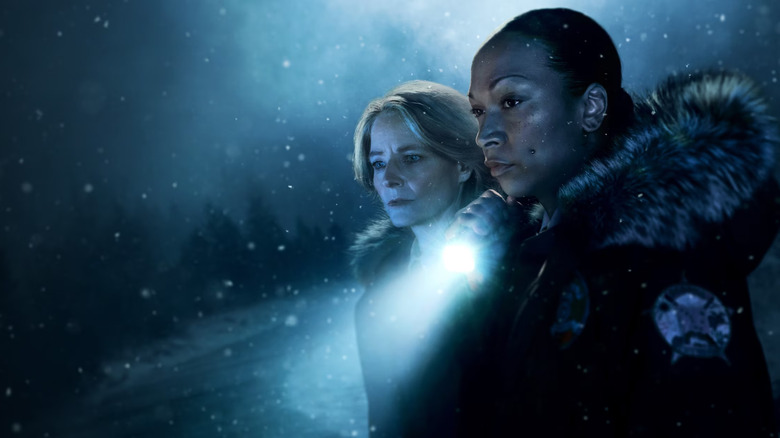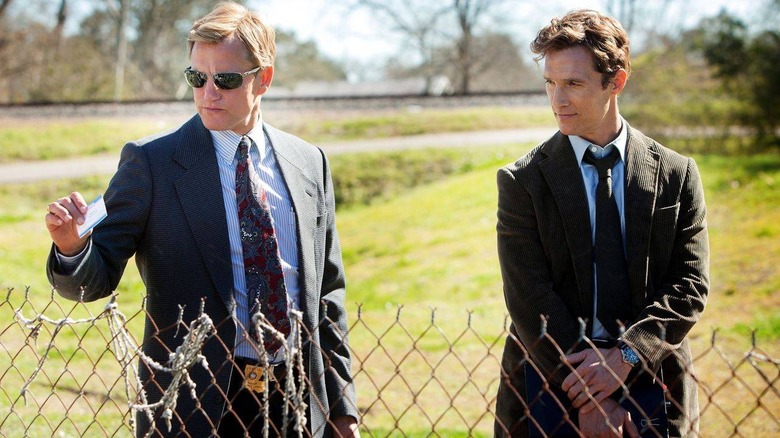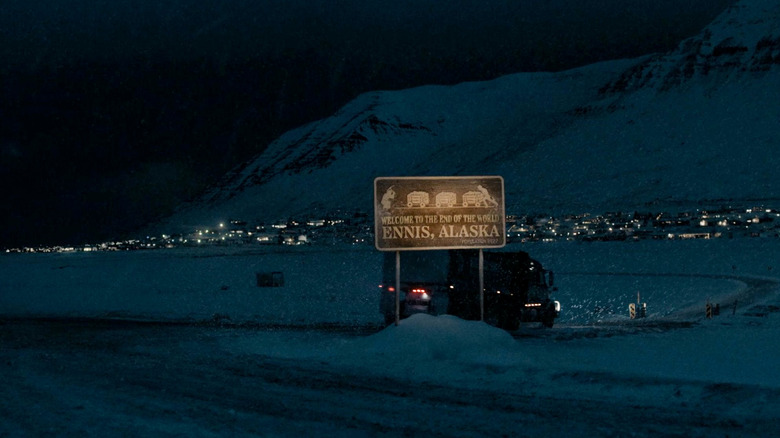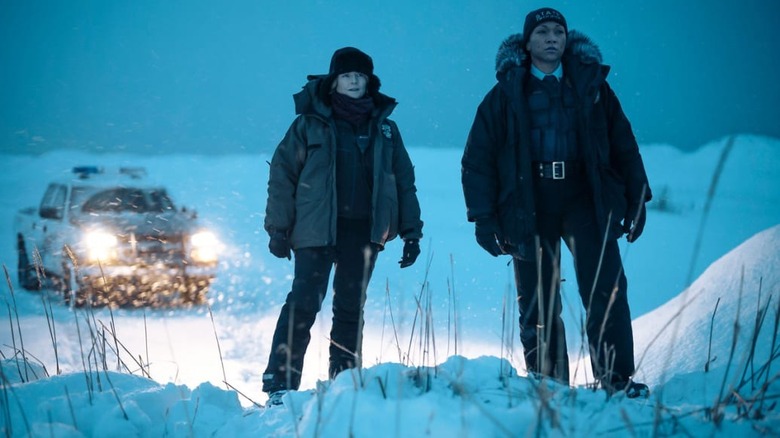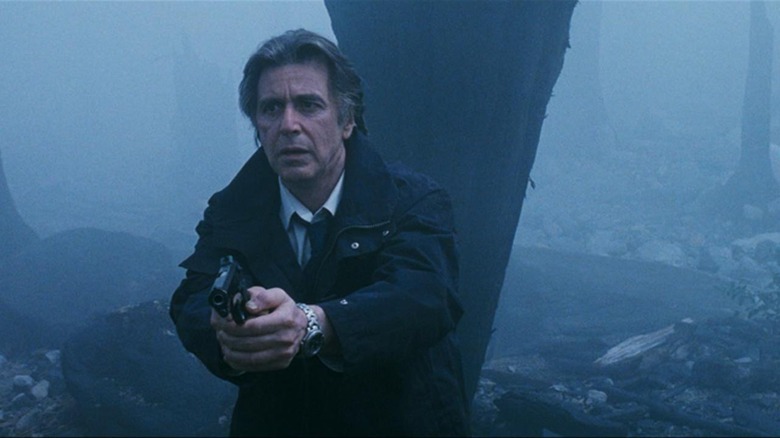How Each Season Of True Detective Is Defined By Its Location
Over the past three seasons of "True Detective" and in the freshly-premiered fourth season, "True Detective: Night Country," the setting is more than just a backdrop for the story. It's a crucial element intricately connected to the unraveling mystery. Since the anthology series premiered in 2014, with a season led by Matthew McConnaughey and Woody Harrelson and set in the backwater towns and rural locales of Louisiana, finding out the location of the next story has been almost as exciting as meeting the new detectives.
Your environment shapes every aspect of your life: your behavior, your interactions with others, your cultural and historical roots, and your perception of the world. Whether it's a small town or a bustling city, a frozen tundra or a sweltering bayou, every place has inner workings that shape its people and their actions. These unique spaces are silent witnesses to the crimes that occur, and the detectives must search for clues in their hidden corners.
Seasons past
In the original season of "True Detective," the Louisana Bayou acts as a pressure cooker for Detective Rust Cohle (McConnaughey) and Detective Marty Hart (Harrelson) as they try to uncover a decades-long mystery involving a sinister cult. The sweeping exterior shots take in murky swamps, dilapidated houses, and decaying industrial complexes. The backwoods are deep and thorny, so far removed from society that their denizens can easily commit heinous acts. It's an intense locale marred by sweltering heat and rapid decline. "Place is going to be underwater within 30 years," Rust remarks. It looks and feels like hell on earth, which perfectly matches Rust's nihilistic view of the world.
"True Detective" season 2 traded rural poverty for the expansive urban setting of Southern California. Through sleek, noir-inspired visuals, we explore both the glamour and the grit of Hollywood through various locations, from seedy strip clubs to Malibu beaches, ritzy casinos, and sprawling Pasadena mansions. It's a world of bright neon lights and long, dark highways. The story of a high-speed rail line hints at forging connections between the coastal locale's disparate ways of life.
The Ozarks provided a more bucolic setting for "True Detective" season 3. The dense forests, sparkling waterfalls, and vast mountains that border the small town of West Finger, Arkansas, have a captivating yet eerie natural beauty. These picturesque surroundings provide a striking contrast to the sinister crimes involving young children that took place there. The labyrinthine, tangled woods can also be seen as a metaphor for Detective Hays' (Mahershala Ali) confused mind and fading memory as he struggles to recall a case that spans back to the 1980s.
Welcome to the end of the world
"True Detective: Night Country," takes us to a radically different setting: the fictional town of Ennis in northern Alaska, 150 miles north of the Arctic Circle. A sign reading "Welcome to the End of the World" greets its citizens and visitors (the few that there are). It's a small, quiet, blue collar community where everyone seems to know each other. The frostbitten, uninviting climate that engulfs this reclusive location seems to mirror the tough main characters, Liz Danvers (Jodie Foster) and Evangeline Navarro (Kali Reis).
"Night Country" begins on the last sunset of December which plunges Ennis into perpetual darkness, making this frigid, insular setting feel even more haunting. Writer and director Issa López uses the pitch-black environment to inject horror elements into the latest "True Detective" mystery.
The first episode features familiar iconography such as dancing shadows, a mysterious man standing in a snowstorm, and strange animal behavior. You never quite know if what you are looking at is real or not. The shots of the Tsalal Arctic Research Station where the climate change researchers went missing, now empty and cold, are reminiscent of the isolated terror of John Carpenter's "The Thing" (a VHS copy of that film can be seen on a shelf in the research station). López uses the stark shadows, often illuminated by a sole flashlight, and vast empty spaces of various Alaskan sites to create the unnerving feeling that something terrifying is lurking around the corner.
'Ennis killed Annie'
"Ennis killed Annie," Liz Danvers bitterly remarks about the Indigenous activist whose tongue was found on the research facility floor. In this season of "True Detective," the mystery seems greater than human-on-human crimes, and extends to the very planet we inhabit. Something greater must be affecting the Alaskan wildlife, causing a herd of elks to launch themselves off a cliff and a one-eyed polar bear to wander through town. Whatever this is may be connected to the environmental researchers who were killed.
The chilling (pun intended) shot of the missing men frozen in ice — transformed into twisted "corpsicles," as the detectives call them — emphasizes that the severe conditions of Ennis are as much of a threat as its people. It is a place where even the simple act of stepping out your front door is taking a step into peril. It'san eerie and intense environment, fraught with historical trauma and tension between the Indigenous people and the mining company that lords over the town. There is something rotten in Ennis, not only within its residents but within its very nature.
Other stories set in Alaska
Alaska is a powerful setting that makes for truly compelling cinema, especially within the mystery and horror genres. "True Detective: Night Country" immediately brings to mind Christopher Nolan's "Insomnia," where the perpetual daylight in the summer drives Al Pacino's Detective Will Dormer to experience hallucinations and delusions. Much like Ennis, although with light instead of darkness, the glacial locale of Nightmute has a confusing sense of time that wears down on Dormer's body and soul. Nolan uses exterior shots to emphasize the foreboding surroundings — the arctic wastelands, rolling mountains, and foggy woods — that seem to swallow the characters whole.
John Sayles' "Limbo" similarly explores the overwhelming brutality of the Alaskan wilderness when a family gets stranded after a seaplane crash. They struggle to survive amidst the bitter cold while searching for food and fire. The seclusion of the setting, along with the strange discoveries they make on the island, reflect the characters' liminal states of being, particularly their uncertainty about what they want from life. "Limbo" literally ends with the family in limbo, leaving it uncertain as to whether or not they will be rescued or continue to be at the mercy of this treacherous environment.
López's horror genre stylings in "True Detective: Night Country" also bring to mind "30 Days of Night." That horror film similarly used the constant night-time to create a disorienting and frightening atmosphere, as well as the catalyst for a flock of vampires who massacre a small town. The residents must brave a harsh blizzard to avoid being killed by the bloodthirsty monsters. In these films and other stories, Alaska emerges as a place of untamed beauty that is fraught with danger.
New episodes of "True Detective: Night Story" premiere Sundays at 9 p.m. ET on HBO.
